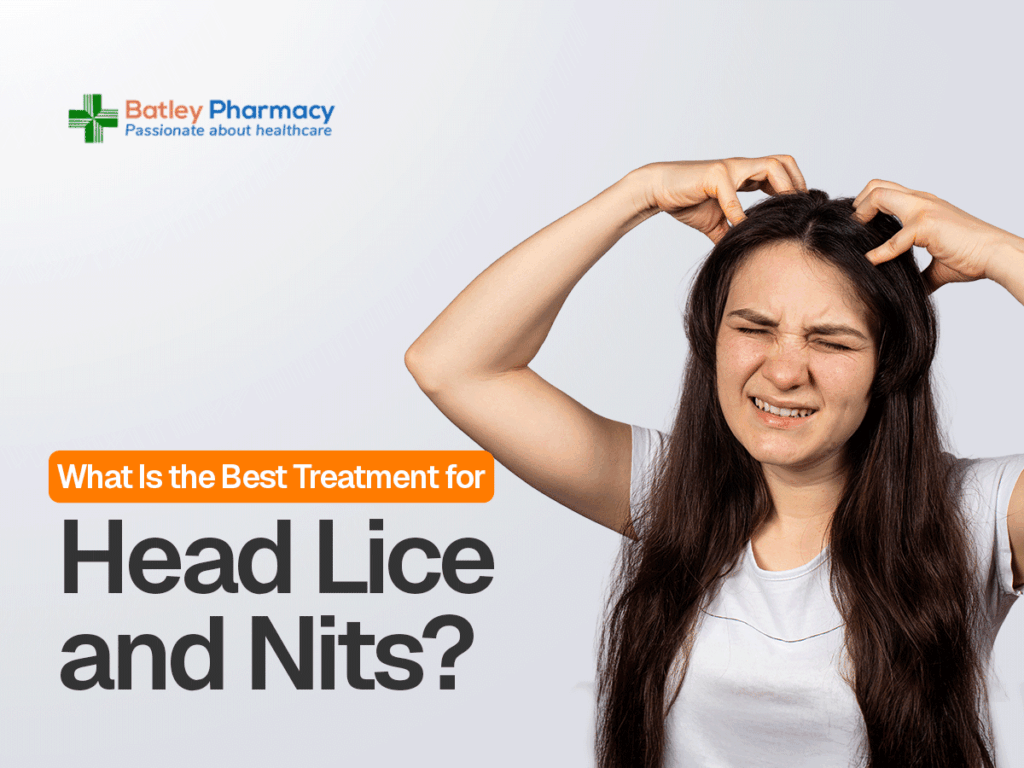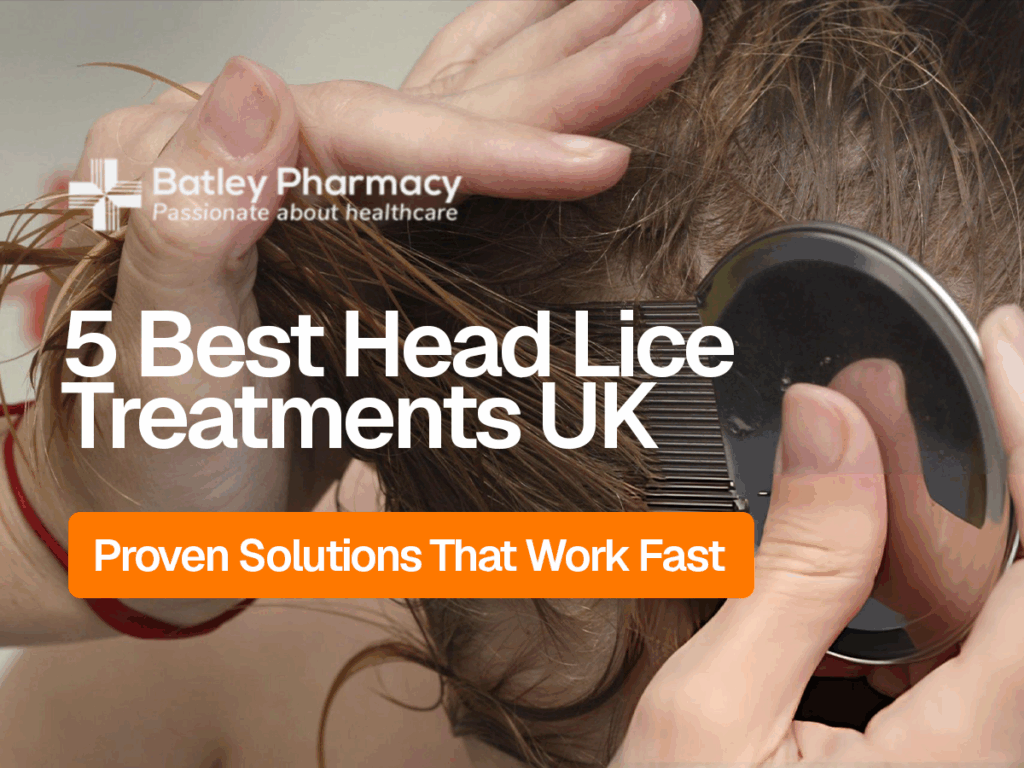Head lice can be a common and unpleasant problem, particularly among school-aged children and their families. Despite being harmless, they can cause persistent itching, discomfort, and social embarrassment. Outbreaks tend to occur in close-contact environments such as schools and nurseries, where children play, share items, and come into regular head-to-head contact.
For families looking for professional support, Batley Pharmacy offers an NHS head lice treatment that helps detect, treat, and prevent infestations through evidence-based care and expert advice. This guide will explore the causes, signs, and best head lice treatment UK options available, including both over-the-counter lice treatment and natural head lice remedies, helping you choose the most effective lice removal UK solutions.
Understanding head lice causes and symptoms is the first step in preventing and managing infestations effectively. With the right information and timely treatment, head lice can be cleared quickly and safely.
What are head lice?
Head lice are tiny parasitic insects that live on the human scalp and feed on small amounts of blood from the skin. They move by crawling rather than jumping or flying, and they rely entirely on human hair to survive. The medical term for a head lice infestation is pediculosis capitis.
Although head lice are a common problem, especially among children, they are not a sign of poor hygiene or unclean hair. They can affect anyone regardless of age, hair type, or lifestyle. While head lice do not pose a serious medical risk, they can cause itching, irritation, and discomfort, making them an unpleasant and often distressing experience for families.
Causes of head lice
How head lice spread
Head lice spread primarily through direct head-to-head contact. For example, during playtime, sports, or hugging, lice can crawl from one scalp to another. This is the most common way infestations begin and spread, especially among school-aged children who often have close physical contact.
Lice can sometimes be transferred through shared personal items such as hats, hairbrushes, scarves, or pillows; this type of spread is far less common. Lice cannot jump or fly, and they survive for only a short time away from the human scalp. It is important to remember that head lice affect all hair types, whether clean or dirty, long or short.
Why you might get an infestation
Because children tend to have closer head-to-head contact (in school, playing, etc.), they are most often affected. The socio-behavioural pattern means they are more at risk. A 2024 systematic review found that among primary school children in low- and middle-income countries, the prevalence of head lice was about 19.96%. That said, head lice remain a common nuisance in the UK.
Signs of head lice infestation
Recognising the infestation early means treatment can be more effective. Common signs include:
- Itching of the scalp and neck, especially at the back of the head and behind the ears.
- A feeling of something moving in the hair.
- Presence of live lice on the scalp.
- Eggs (nits) attached to hair shafts near the scalp.
Nits and lice differences
The term “nits” refers to the eggs or egg-cases of lice. They are typically white or yellow-white and firmly attached to the hair shaft, near the scalp. These are not the same as live lice. Finding a nit alone does not necessarily mean there is an active infestation unless live lice are seen.
Additional observations
You may find tiny bite marks on the scalp, redness or irritation from scratching and sometimes secondary bacterial infection if scratching is excessive. Though rare, these complications may occur with prolonged infestation.
Best head lice treatment UK (and lice removal UK)
When you are dealing with head lice, there are several treatment approaches available in the UK.
Mechanical removal (wet combing)
This method involves using a fine-toothed detection/combing tool on wet hair with conditioner to manually remove lice. It is recommended by UK guidance as a first-line or adjunctive approach. For example, the process involves shampooing, applying conditioner without rinsing, then sectioning the hair and combing from the scalp to the ends with a special comb, repeating this process every few days until no lice are found.
Over-the-counter (OTC) lice treatment
Lotions and sprays, available from pharmacies and supermarkets without a prescription, may contain insecticidal agents (e.g., permethrin) or physical-mode treatments (e.g., dimeticone) that suffocate lice. UK guidance notes that these should be used once a live louse has been found.
Professional or pharmacy-led service
At Batley Pharmacy, our NHS head-lice service allows for professional assessment, detection, combing, selection of the best product and guidance on usage. We also assist in liaising with schools if required.
Treating head lice at home
Here is a practical step-by-step approach you can do at home (with our pharmacy support):
- Check for live lice using a detection comb on damp hair with conditioner.
- If lice are found, treat all affected people in the household on the same day.
- Choose treatment: wet combing or OTC lotion/spray (or both) according to our guidance.
- Repeat combing at intervals to catch newly hatched lice.
- Avoid sharing hats, brushes, and pillows; wash hair accessories and combs in hot, soapy water.
- Regularly check everyone’s hair for a few weeks until you’re confident the infestation is resolved.
If treatment fails or lice persist, return to the pharmacy for further advice; there may be resistance or alternative treatments needed.
Why use a pharmacy-led NHS service?
At Batley Pharmacy, we provide an NHS-commissioned head-lice service:
- Expert assessment using detection combs and identification of live lice.
- Clear advice on treatment scheduling, follow-up combing and prevention.
- Liaison with schools or childcare settings if required.
- Affordable (often NHS-funded) access without needing a GP visit.
This approach means better outcomes and fewer repeat infestations.
Summary
Knowing the head lice causes and symptoms helps you spot infestation early. The head lice treatment UK includes mechanical removal (wet combing), OTC insecticidal/physical treatments, and pharmacy-led services. While natural head lice remedies may be appealing, the evidence is limited relative to standard treatments; over-the-counter lice treatment remains the backbone of most case management. At Batley Pharmacy, our NHS head-lice service offers professional, evidence-based support for families facing this challenge.
FAQs
Once removed from a human scalp, head lice usually survive only 7-10 days, and eggs about 10 days away from the host.
Treat all affected people simultaneously, avoid head-to-head contact, don’t share hats/brushes, and check hair regularly with a fine-toothed comb.
Head lice are passed by direct scalp-to-scalp contact; sharing items plays a minor role. Hair cleanliness, length or style are not the main causes.
Use a detection comb on damp hair, apply wet combing method or OTC treatment as appropriate, repeat combing and treat everyone in the household if live lice are found.
The best treatment depends on age, infestation severity and previous treatments. Batley Pharmacy, offering NHS advice, will guide you.
Check hair weekly, avoid close head contact, avoid hat/brush sharing, treat promptly if live lice are found, keep communication open with peers/schools.
No, they rarely cause serious health issues in the UK. The main effects are itching, discomfort and social stigma.
OTC lotions, sprays and detection combs are sold by pharmacies, supermarkets and online. Batley Pharmacy can advise you on the correct product and usage.
Use a fine-toothed detection comb on wet hair with conditioner, comb from scalp to tip section by section, and look for live lice.
It is extremely unlikely that lice will survive long on pillows; they need human scalp blood and die within days off the head. Focus treatment on the hair rather than the pillows.
Lice spread through direct contact. If one person is infested and unchecked, they can move lice to others within days.
Yes, while you should treat your hair and avoid sharing pillows/bed linen until treatment is underway. Ensure your treatment plan is followed and that others sharing the bed are checked.


